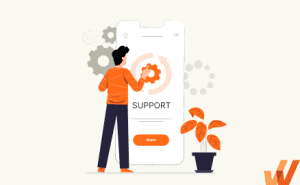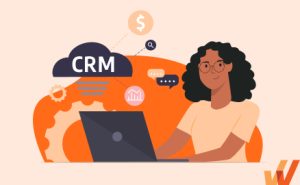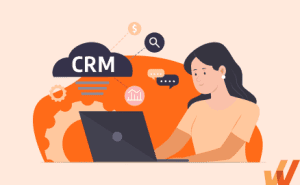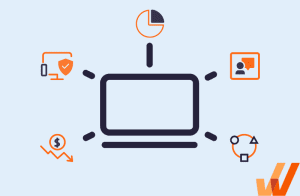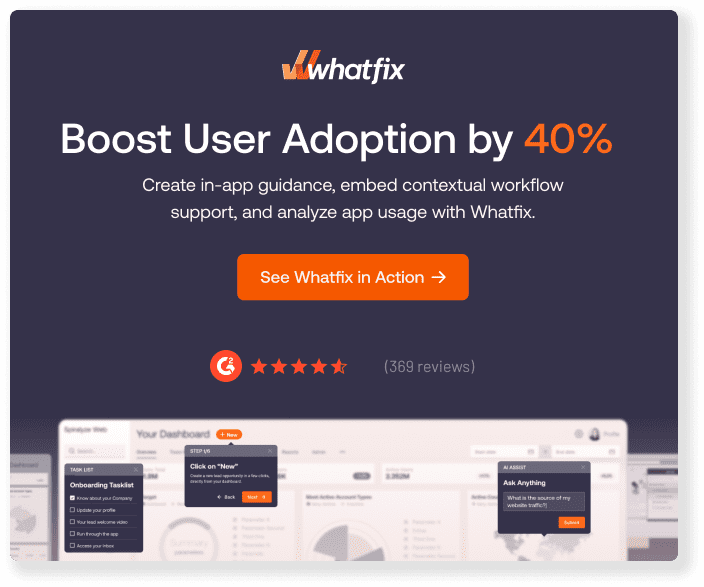CRM software is mission-critical for large, modern sales teams, but unlocking their full potential requires more than just deploying the software and handing out a training manual. Traditional training methods like one-off seminars, classroom instruction, and static documentation fall short when enabling today’s sellers. These methods often overwhelm users, offer little knowledge retention, and fail to provide real-world selling guidance. As a result, sales reps revert to old habits or underutilize the CRM, leaving productivity gains and ROI on the table.
Today’s sales professionals operate in high-pressure, fast-moving environments where learning by doing is critical. They need immersive, hands-on training experiences that mirror the actual workflows they’ll be executing in the CRM, such as managing pipelines, updating deal stages, and logging customer interactions. Generic, one-size-fits-all training doesn’t work. Reps require contextual, role-based sales training tailored to the tools and tasks they’ll use every day. This shift from passive learning to active enablement is essential to drive true CRM adoption.
What’s more, training can’t stop at onboarding. Continuous learning and support must be embedded directly into the CRM experience to reinforce behaviors and boost productivity. This means providing just-in-time, in-the-flow-of-work guidance that helps sellers complete tasks accurately without breaking their workflow. In-app walkthroughs, task lists, tooltips, and smart self-help tools not only accelerate learning curves, but ensures that your CRM becomes a true productivity asset rather than a burdensome data-entry tool.
In this article, we explore how organizations can modernize their CRM user training programs to drive stronger adoption and performance. You’ll discover best practices for CRM user training and see how Whatfix for CRM empowers sales teams with contextual, in-app guidance that supports reps in the flow of work. We’ll also dive into how Whatfix for CRM helps companies accelerate ramp times, improve data hygiene, increase seller engagement, and maximize CRM ROI.
Why Is CRM User Training Important?
CRM user training provides sellers the foundation they need to complete their tasks, achieve their sales goals, and maximize their productivity. Here are five key reasons your sales organization must invest resources into building a contextual CRM end-user training plan.
1. Reduces time-to-proficiency for new sellers
Organizations face the challenges of comprehensively onboarding new sellers and providing them enough time to learn product knowledge and sales processes—all while facing the pressure to get new sellers productive quickly.
However, with proper CRM training, sellers can adopt your contextual sales processes and complete the tasks assigned to them in your CRM. This leads to sales process mistakes, dirty CRM data, overlooked sales signals, and missed opportunities.
By providing comprehensive training, you equip your new sellers with the necessary knowledge. They’ll be able to use your CRM efficiently, allowing them to focus on what they do best and confidently use the technology. This accelerates time-to-proficiency for new CRM users and enables your sales organizations to achieve CRM ROI.
PRO TIP
With Whatfix Mirror, quickly create sandbox CRM application environments without technical dependencies to provide hands-on training to sellers without risking live software usage. Guide new sellers with in-app Tours, Task Lists, and Flows to become proficient CRM users and accelerate new hire onboarding quickly.

2. Maximizes CRM ROI and drives business outcomes
Global digital transformation spending is expected to reach $3.9T by 2027 and the CRM market alone could topple $130B by 2028. An average CRM implementation can cost an enterprise organization upwards of $500K, not including the subscription, training, and ongoing support. You need to make that investment pay off for your organization. Effective user training unlocks the CRM’s full potential, maximizes CRM ROI, and achieves sales outcomes intended by the investment.
When well-trained, users may use more of the CRM’s features and the data this solution offers to make better decisions. This leads to improved sales processes and customer relationships. CRM training turns your software investment into an engine for positive business outcomes.
3. Ensures CRM data is entered accurately and consistently
Data quality is one of the biggest problems facing data teams. One 2023 study shows that dirty CRM data has more severe repercussions on an organization’s revenue and data trust than in years prior.
The quality of your CRM data directly impacts business insights. Training instills best practices for data entry and management in your team. You want to focus on data integrity. This makes your CRM a reliable single source of truth for your organization.
4. Drives productivity of CRM users
64% of managers report that employees now have additional job responsibilities. For sellers, the majority of those tasks are done within a CRM. However, our Digital Adoption Trends Report found that a third of all new hires received less than hour of training and onboarding for the software applications and digital tasks they’re responsible for. 78% of employees said they lacked the digital expertise in these tools to take full advantage.
A well-trained CRM user is a productive CRM user. When your team knows how to navigate the system efficiently, they spend less time on data entry, searching for CRM documentation, and asking colleagues for help. They can spend more time building customer relationships and closing deals.
Training also helps users discover productivity-boosting features they might otherwise overlook. From automated workflows to custom reports. Training empowers people to use these tools to streamline their work and accomplish more in less time.
5. Improves sales process governance
Building workflows and creating contextual process documentation are just the first steps. You must implement a process governance strategy. This improves individual performance and enhances team collaboration. It can also make sales forecasting more accurate.
Your CRM is a tool for standardizing and optimizing your sales process. However, with effective CRM training, your team will utilize the platform correctly and consistently. You can ensure that all users understand your organization’s sales stages through targeted training.
6. Drives adoption of new CRM features, updates, and workflows
CRMs are constantly evolving. From new features launched by the CRM vendor, new updates pushed by your internal CRM IT team, or changes your CRM’s tasks and processes, end-user sellers require communication, intervention, and guidance to drive adoption of these changes.
How to Create a CRM User Training Plan
While every sales team will have contextual processes, goals, and training needs, here are nine steps to building a CRM training program that enables sellers.
1. Identify your CRM end-user needs and roles
First, know your audience. Not all CRM users are created equal. For example, a sales manager will have different needs than a BDR. Start by mapping out your seller roles based on how they will use your CRM.
- What are their primary responsibilities?
- What tasks will be completed with the CRM?
- What CRM features will they use most often?
- What are their current skill levels?
Discuss with your sellers what their level of familiarity is with CRMs and your specific CRM tasks. Collect seller feedback to confirm your conclusions and work with your L&D team to identify skills gaps. From here, you can tailor your CRM training to address the specific needs of each user group. This approach ensures that each user receives relevant and impactful training. This can motivate employees to adopt the new system.
2. Provide hands-on training with a CRM sandbox environment
Theory is great, but practice makes perfect. The 70-20-10 rule of learning states that employees learn 70% of knowledge from hands-on experiences, 20% from social experiences, and 10% from traditional training types.
A sandbox environment provides a safe space for hands-on training for your CRM users to experiment and learn without fear of making mistakes that could impact their business.
PRO TIP
With Whatfix Mirror, you can create interactive replicas of web applications for virtual hands-on user training. You can even provide easy access to your simulated software training environments by generating a shareable link or adding them as learning modules in your LMS. Users can practice workflows and even simulate complex scenarios in this risk-free environment. This hands-on experience builds confidence and competence, which prepares users for real-world CRM use.

3. Create contextual in-app onboarding and training
Context is king wtih CRM training. Don’t risk overwhelming users with a firehose of information or boring them with outdated training methods. Instead, enable them with bite-sized, contextual training within your CRM interface. Offer just-in-time instructions and in-app guidance as users navigate through your business processes and digital tasks.
For example, consider when a user hovers over the “opportunity” button for the first time. A tooltip could explain what define’s an “opportunity”, use in-app guidance to walk you through how to create a new opportunity, and field validations that let you know fields are mandatory in the opportunity details. This would make learning more digestible and empower users to apply what they learn faster.
Whatfix DAP is a digital adoption platform that provides organizations with a no-code tool to create in-app self-guided experiences that are contextual to different types of end-users. The platform also connects knowledge repositories to in-app resources, providing help at the moment of need.
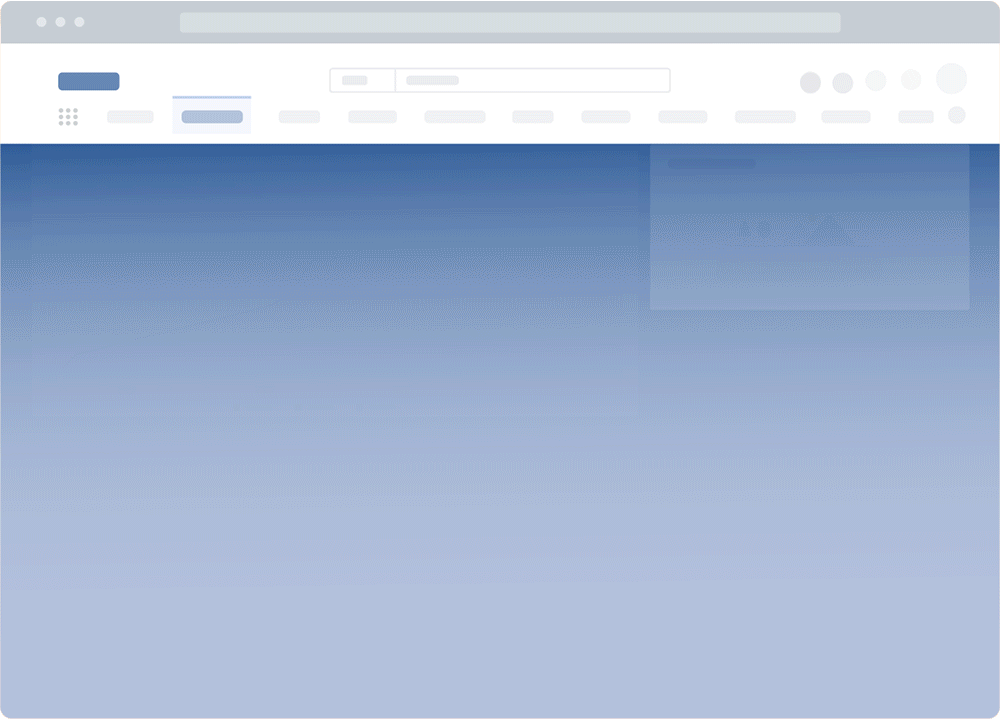
With Whatfix, quickly create:
- Tours and Task Lists for onboarding new employees or implementing a new CRM.
- Flows for providing in-app guidance to drive adoption of complex or infrequently done sales tasks.
- Field Validations ensure data is entered correctly, in the right format, for different regions or product lines.
- Smart Tips for providing additional context or knowledge at key friction points.
- Pop-Ups for making team announcements, alerting users of deadlines, or driving change or feature adoption.
- Self Help provides users with a help center that integrates with your training and knowledge repositories, providing help at the moment of need.
4. Use real customer scenarios in training exercises
Incorporate real-world scenarios to bring your CRM training to life. Use anonymized data from actual customer interactions to create training exercises. That will help prepare your team to handle tasks they deal with every day.
For example, you could create a scenario where a user needs to update a customer record after a sales call. They’ll need to create a new opportunity and schedule a follow-up task. This can teach CRM skills in a practical way.
5. Include different CRM training methods and learning formats
There are many different learning styles, each with their preferred way of learning. Some sellers may prefer video tutorials; others may learn best through traditional training with interactive quizzes or written guides. This is why offering training methods and learning delivery matters. Emerging adaptive learning technologies use AI and CRM user inputs to adjust and personalize learning on the fly.
By creating personalized, contextual CRM training paths that drive knowledge acquisition and improve learning retention, you can cater to your sellers’ different learning preferences.
CRM application owners, L&D teams, and sales leaders can work together to provide CRM end-users training through a variety of formats, mediums, and methods, including:
- In-app guidance to enable sellers with interactive pop-ups, tooltips, walkthroughs, task lists, and tours that overlay your CRM UI.
- Step-by-step written guides and SOP documentation.
- LMS courses and traditional instruction-led training.
- Webinars and Q&A sessions.
- Video tutorials and screen recordings.
- CRM blogs and sales influencers on YouTube.
- CRM communities like Salesforce’s Trailhead community.
- Sales coaching, third-party trainers, and CRM consultants.
- CRM certifications and online course providers.
Your CRM training library needs to account for in-person learning, courses, video recordings, and written SOP documentation—all on top of your in-app guidance and training that users can interact with hands-on.
6. Provide CRM users with continuous in-app reinforcement training
One-third of employees say it is hard to stay motivated with training at work. 25% also say that after training is complete, they quickly forget the material. Application owners and sales leaders must also plan for the forgetting curve effect concerning your CRM user enablement strategy.
Remember that learning doesn’t stop after the first training session. Continuous reinforcement is vital to long-term CRM adoption. Implement an ongoing training program that keeps users updated on new features and reminds them about best practices.
With a DAP like Whatfix, your in-app guided experiences provide performance support in the workflow and when and where users need it. This provides a guardrail that ensures employees use your CRM correctly.
7. Provide on-demand CRM performance support
All users will occasionally need help. Empower your team with on-demand support resources and give them access to information to overcome any roadblocks they may encounter while working with the CRM.
This could include CRM user support channels and mediums like:
- A searchable knowledge base
- Short video tutorials
- An AI-powered chatbot
- A dedicated support channel
PRO TIP
Whatfix DAP enables CRM users anytime with Self Help. Self Help overlays your ERP UI and provides a searchable help center that integrates with your LMS, CRM SOPs, sales training resources, videos, third-party links, and more.
This aggregates all your CRM processes and support documentation into one in-app help center. Whatfix tracks user searches to identify common friction points or areas where support is needed more, helping you create new support articles or training sessions your users need.

8. Schedule live Q&A sessions with trainers and internal power users
Regular Q&A sessions allow users to ask questions and learn from each other’s experiences. Bring in certified trainers or internal CRM power users to lead these sessions. They can interact with their peers and record conversations for future reference.
9. Collect CRM user feedback and use feedback loops to improve training
Your CRM training program should change with user needs and experiences. Regularly collect feedback from your users. You need to know their thoughts about the training and their CRM experience.
Look for insights on:
- What’s working well?
- Where are users still struggling?
- What additional training do they need?
Whatfix provides application owners and IT managers with a tool to create in-app surveys to collect ERP feedback inside your application. These can be open- or close-ended questions, surveys, questionnaires, interviews, and focus groups designed around different parts of the product experience such as ease of use, functionality, training effectiveness, and overall user experience.
10. Analyze how users engage with your CRM to modify processes and improve training
Use end-user behavior analytics to see how your team is actually interacting with the system. It’s helpful for enterprise application owners to understand which features your employees are using the most, what step your sales processes cause the most friction, and what sales tasks are driving outcomes.
You should also examine where they might be experiencing frustration and where opportunities for improvement exist.
A platform like Whatfix Product Analytics help you collect privacy-respecting CRM usage data from your users, such as:
- System logs that track user activity, including login times, module usage, transaction volumes, and error rates.
- Feature usage metrics (adoption rates, unused features, etc.) that identify if and how much your end-users employ specific features.
- Error logs that signal common issues and bottlenecks within the system.
- Performance metrics such as uptime, response time, and transaction processing time.
- User metrics like task completion, user satisfaction, and error rates, etc.
These data points will help you assess how your end-users interact with your product and your help resources. Use Funnels and Journeys to see how your users interact with your process and identify inefficiencies and friction. Compare groups of users with Cohorts to see how different business units are adopting processes and where issues happen.
This can help you identify areas where additional training could be helpful. For example, if many users are struggling with a particular report, you might create a targeted training module on report creation.
Examples of Corporate CRM Training Programs Powered by Whatfix
To understand how Whatfix enables organizations to provide in-app training and CRM user support in the flow of work, let’s look at how four enterprise companies drive sales outcomes and enable sellers with guided CRM training:
1. REG
Renewable energy enterprise REG is a fast-growing business with 1,200+ employees. It relies on mission-critical software like Salesforce CRM and JD Edwards ERP to operate and achieve its business outcomes.
With no standard, enterprise-wide training process, tribal knowledge emerged, with people trained in various ways to use the CRM and ERP. REG’s growth compounded the problem: the moment new training content was launched, new undocumented application features often superseded it. The result was reduced productivity and potential accounting errors.
REG then standardized its software training and support using Whatfix to provide in-app guided training at the moment of need. With Whatfix DAP, CRM and ERP users followed simple step-by-step instructions within the applications (called Flows) to break down complex processes or infrequently done tasks, driving end-user adoption and productivity.
On-demand help combined with in-application guidance and internal knowledge bases are also helping to create a self-learning culture, empowering REG to take charge of its application knowledge.
With Whatix, REG accelerated its time-to-proficiency for new hires to become proficient CRM users by 50%, equivalent to a three-month faster ramp-up time.
2. Sophos
SaaS cybersecurity software company Sophos invested in Salesforce CRM to transform its sales processes and increase sales outcomes like improving win rates, streamlining operations, and managing relationships better. To continuously improve, Sophos releases monthly Salesforce updates to better suit internal requirements.
With its sellers spread across seven countries, it becomes difficult for the sales team at Sophos to manage these releases and effectively manage change for its CRM end users. Enter Whatfix.
With Whatfix DAP, Sophos enabled its sellers with:
- Guided training: Sophos effectively used Whatfix to increase recall of onboarding training. With Whatfix, updates, communication, and training happened in real time. With new information directly within the Salesforce app, employees learned in the flow of work and received interactive guidance when it was most needed.
- In-CRM support: Sophos SDRs now had access to a 24/7, personalized in-app digital assistant in the form of Whatfix Self Help, with on-demand sales and CRM information, not just from Whatfix content but also from its integrated knowledge bases. This has eliminated the need for users to raise support tickets. As a result, sales reps quickly moved on with their tasks instead of waiting for the tickets to be resolved. By doing so, Sophos experienced a global 15% (~12,000 tickets) reduction in sales operations support tickets.
- CRM compliance: Sophos ensured users remained compliant using in-app Smart Tips that provided contextual information on each new Salesforce button, form field, action, or flow. With 116,061 Smart Tips shown in total in 12 months (which breaks down to 400 Smart Tips engaged with daily), users became more confident and proficient with Salesforce.
- Unified CRM user communication: Sophos took a systematic approach toward its Salesforce change and launch plan. First, it created interactive walkthroughs and product tours to introduce Salesforce, its basic functionality, and its core features and workflows such as lead and opportunity creation. Next, it moved to slightly more complex features that its users were experiencing friction with and created guided walkthroughs and intelligent pop-ups to overcome these challenges. Sophos also used Whatfix to align its sales and product management teams by embedding videos and other media to unify all product communication instead of relying on various communication tools.
3. Experian
Consumer credit reporting company Experian made a significant investment in its CRM transformation by implementing Salesforce CRM. However, due to heavy customization, the Salesforce experience was complicated and hard to navigate.
It also faced the challenge of its Salesforce training material becoming obsolete every time Salesforce released a new release or when Experian changed internal sales tasks and workflows.
Experian turned to Whatfix to provide interactive, on-demand training to help users in the flow of work and drive agility and greater Salesforce engagement. Whatfix also provided real-time training and onboarding assistance personalized to each user’s role across Salesforce and several integrated applications, such as its CPQ and eSignature platforms.
Whatfix helped Experian provide real-time training and onboarding assistance that was personalized to each sales user’s role, language, and instance (which is customized per region and business department), including:
- In-app Salesforce guidance via Flows that reduced Experian’s sales onboarding course from 19 modules to one, and cut training duration time from six hours to 40 minutes.
- Self Help: An always-available self-help menu (internally called ‘guide-me’) provides users contextual information whenever users are unsure how to perform a process or task, saving precious time in asking the SalesOps team for help.
- Smart Tips for Overdue Sales Opportunity Prompts: Pop-ups are conditionally triggered when opportunities are due to close or overdue, nudging the seller to take action. 6,500+ opportunity-related pop-ups are shown to users every month. This prompt can also be turned off for strategic, multi-year sales opportunities.
- Best Sales Practices Alerts: Whatfix alerts salespeople when CRM data is missing or incomplete. A pop-up notifies the user when a CRM score is below a predetermined threshold.
- Auto-Translation: Experian takes advantage of Whatfix’s language translation capabilities and have recently rolled-out guidance to Spanish-speaking users in local language.
4. Hays
Global staffing company Hays utilizes an in-house, custom-built CRM called IRIS to maintain strong relationships and streamline communication in its European offices. With constantly evolving features and custom workflows, employees require a better way to learn how to use the system, adopt new features, and overcome inefficiencies in user flows.
Users can then learn how to use the feature without leaving the application. Previously, a confused IRIS user would contact their manager to find the correct SharePoint folder, read through the list of files that might contain the right help article, and then flip back and forth from the help article to IRIS to try and solve their problems. With Whatfix, users can engage Self Help and get guided help immediately.
The partnership with Whatfix allows Hays to provide in-app training and support for IRIS users. Hays takes advantage of several Whatfix features to make training more efficient. Hays also uses Whatfix to ask its employees what they want to learn and where they have problems. With their answers, Hays can build content to address those needs quickly.
CRM User Training Clicks Better With Whatfix
Empower sellers with contextual, personalized CRM training and in-the-flow-of-work support to accelerate adoption and maximize productivity.
Improve Time-to-Proficiency With Hands-On CRM Training
Reps don’t learn by watching—they learn by doing. Whatfix Mirror enables organizations to create safe, sandboxed CRM environments where sellers can get hands-on experience with real tasks and scenarios. These simulated environments allow users to build muscle memory without the fear of making mistakes in the live system. With guided experiences built into the training flow, sellers ramp up faster and retain more of what they learn. This reduces the lag time between CRM rollout and productivity gains. Faster onboarding means new hires start closing deals sooner and contribute to pipeline growth earlier.

Deliver Contextual, Role-Based In-App Guidance
Not all sellers need the same training. Whatfix allows organizations to build personalized training paths that adapt to each role, team, or responsibility set within the CRM. Reps see only the workflows and guidance relevant to their tasks, whether they’re SDRs qualifying leads or AEs managing late-stage pipeline. Contextual in-app Flows, Smart Tips, and Task Lists guide sellers through daily activities without disrupting their workflow. This ensures they’re not overwhelmed with unnecessary information and helps drive consistent, high-impact usage across different user groups.
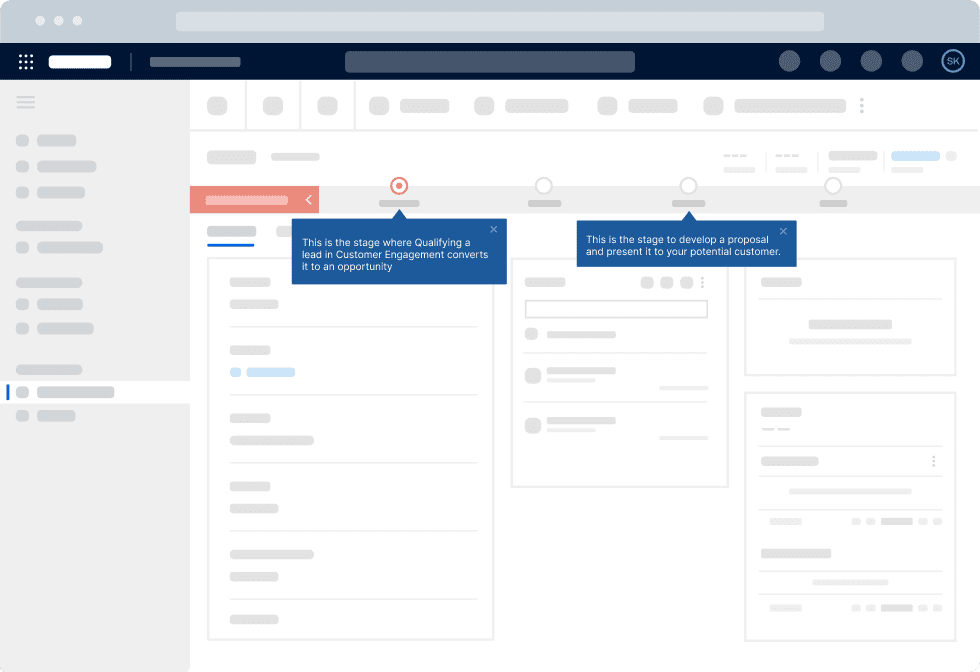
Maximize Productivity With Embedded Performance Support
Training shouldn’t end after onboarding. With Whatfix, CRM training becomes a continuous experience through embedded performance support directly within the application. Sellers receive just-in-time assistance while completing tasks, reducing dependency on support teams and eliminating the need to reference external resources. Smart Help widgets, on-demand walkthroughs, and field-level tooltips provide self-serve enablement that empowers reps to work faster and with greater confidence. The result is more time spent selling and less time struggling with the CRM.
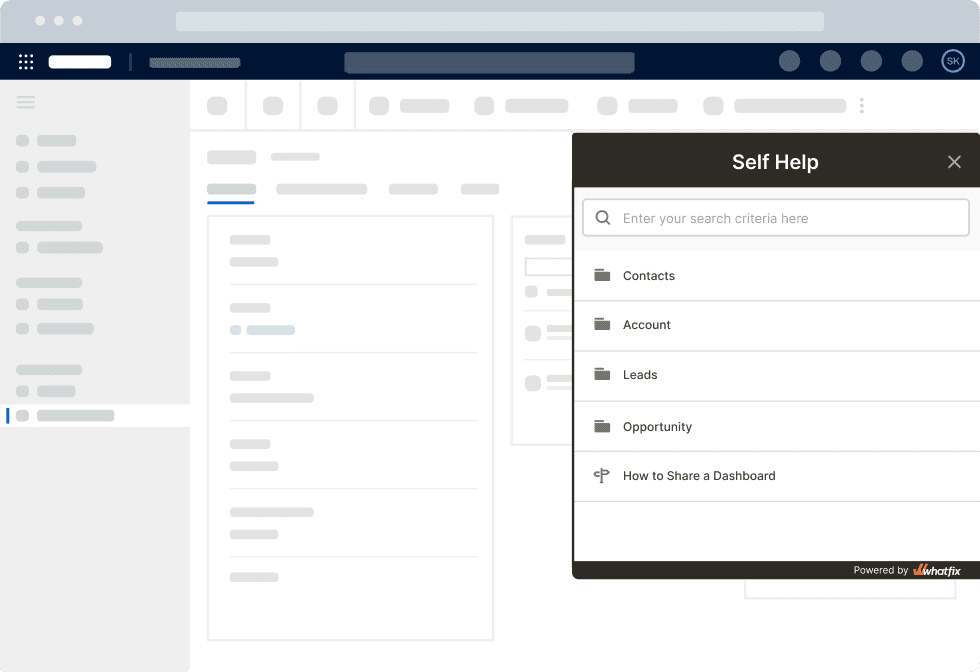
Identify Workflow Friction and User Inefficiencies
Whatfix equips CRM administrators and enablement teams with insights into how users interact with the system. You can identify where reps drop off, which workflows cause confusion, and which steps take the most time to complete. These analytics highlight user friction points that impact productivity and CRM adoption. By surfacing these inefficiencies, Whatfix helps you prioritize where to optimize training or simplify processes, improving the CRM experience for everyone.
Strengthen CRM Governance and Data Quality
Consistent processes and clean data are essential to drive value from your CRM. Whatfix supports CRM governance efforts by reinforcing data entry rules and guiding users through complex processes in a standardized way. In-app field validation, automated prompts, and compliance-focused Flows ensure that sellers follow best practices every time they use the system. This reduces errors, enhances pipeline visibility, and improves forecasting accuracy. Better data means stronger decisions and more predictable revenue performance.

Drive Adoption of Advanced CRM Capabilities Like AI
CRMs are evolving; AI features like predictive scoring, conversation intelligence, and next-best actions are now commonplace. But sellers won’t adopt these capabilities unless they’re properly trained on how and when to use them. Whatfix helps bridge that gap by delivering in-context coaching and walkthroughs that drive adoption of new and advanced CRM features. Reps get clear, guided experiences that encourage exploration and confident use of advanced features, ensuring your investment in next-gen CRM tech translates into real business value.
Manage Sales Change With Embedded CRM Communication
CRM processes are always evolving; new deal stages, updated qualification criteria, fresh integrations. Communicating these CRM changes effectively to sellers is often a major challenge. Whatfix makes it easy to roll out updates with embedded announcements, Pop-Ups, and banners that appear directly inside the CRM. You can target communications to specific roles or regions and reinforce changes with in-app walkthroughs. This keeps your teams aligned and reduces the disruption that often accompanies sales process shifts.
Optimize Workflows and Daily Tasks Inside the CRM
Sales productivity is won or lost in the day-to-day experience of using the CRM. Whatfix streamlines that experience by optimizing workflows and simplifying complex or multi-step processes. Users get real-time guidance that removes guesswork and accelerates completing key tasks like logging calls, updating deal stages, or adding contacts. These small efficiency gains compound over time—freeing up reps to focus more on selling and less on figuring out how to use the tool.
Ready to get started with Whatfix? Request a demo today!

